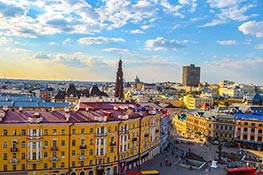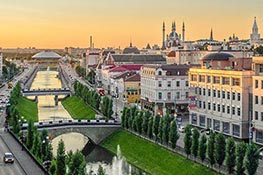20 August 2018
Kazan – where east meets west
On the banks of the might Volga river, Kazan has a history dating back 1,000 years but is modern, vibrant cosmopolitan city that is no stranger to hosting major international events.

On the banks of the might Volga river, Kazan has a history dating back 1,000 years but is modern, vibrant cosmopolitan city that is no stranger to hosting major international events.
Football fans will know Kazan from this year’s World Cup, where it hosted the quarter final between Belgium and Brazil, and France’s narrow defeat of Argentina.
Hosting events like the Universiade Games and the FIFA Confederations Cup has provided the city has extensive experience welcoming international guests to large events.

The sixth largest city in Russia, Kazan is also the capital of the Republic of Tatarstan, just over 700 kilometres from Moscow.
The majority language is Russian, although Tatar is widely spoken among native Tatars, who make up just under half the population of 1.2 million, which drawn from more than 100 nationalities.
The city is also growing as a tourist destination, with attractions like the Kazan Kremlin, a World Heritage Site as well as over 30 museums and one of the best circuses in Russia.
While the temperature can drop to a chilly minus 10 Celsius, the rest of the year is generally temperate, with an average of around 23 Celsius in August.
Kazan’s economy is diverse, with the largest IT industry in Russia, and industries that include aircraft production, petrochemicals, machinery, and food production.
It is also a major financial centre, with the banking centre said to be in the country’s top three in terms of capital.
With an international airport and rail links across Russia, the city’s international transport networks include trams, trolley buses, nearly 2,000 kilometres of bus routes, bike sharing, and a metro line with ten stations.
Visitors can also expect to encounter Zilant, a legendary creature with the head of a dragon and body of bird. Legend says the beast guards hidden treasure buried under the city, but it can now be seen everywhere on the official coat of arms.